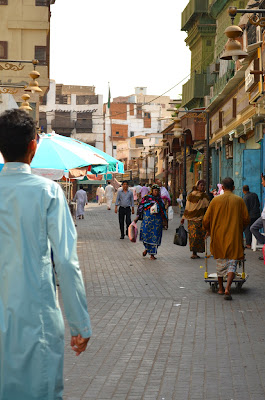 Last night I got my first taste of the local cuisine, in a small village on the outskirts of Jeddah, called Dhabhan. I knew we were going to have fish from the Red Sea and that the restaurant was supposed to be very traditional, so what I was expecting was basically a simple restaurant with traditional Arabian decor, maybe low tables with pillows arranged around them, something to that effect anyway. When we arrived though, instead of entering a restaurant, we were led by one of several employees milling about the parking lot, through a garden with little fountains and as much greenery as the desert permits, to what seemed like a few dozen bungalows. He stopped at number 21 and opened the door. This was to be our own private dining area.
Last night I got my first taste of the local cuisine, in a small village on the outskirts of Jeddah, called Dhabhan. I knew we were going to have fish from the Red Sea and that the restaurant was supposed to be very traditional, so what I was expecting was basically a simple restaurant with traditional Arabian decor, maybe low tables with pillows arranged around them, something to that effect anyway. When we arrived though, instead of entering a restaurant, we were led by one of several employees milling about the parking lot, through a garden with little fountains and as much greenery as the desert permits, to what seemed like a few dozen bungalows. He stopped at number 21 and opened the door. This was to be our own private dining area. Inside, this bungalow-type structure was quite spacious and divided into two parts. On the left side of the door was a round table with red (probably fake) velvet covered chairs all around it. A heavy curtain, also red and of the same material, hung across the large window to ensure customer's privacy. It is very important that customers feel safe from prying eyes, since in these dining areas women remove their headscarves, as to be able to eat more freely.
Inside, this bungalow-type structure was quite spacious and divided into two parts. On the left side of the door was a round table with red (probably fake) velvet covered chairs all around it. A heavy curtain, also red and of the same material, hung across the large window to ensure customer's privacy. It is very important that customers feel safe from prying eyes, since in these dining areas women remove their headscarves, as to be able to eat more freely.On the left side of the door was a rectangular, low table with large, bright turquoise couches arranged around it, like in any living room. Drapes behind the couches were turquoise as well. The color combinations weren't very tasteful, but seemed fitting. There was also a grimy little bathroom in the back. The room was a bit run down in general, some holes in the wall, probably the work of some careless electrician, and the furniture seemed a bit worn as well, but all this just added to the charm, in my opinion.
 After settling in, we walked along a path through more bungalows, to a building which held the kitchen in the back, and had the fish on display in the front. There wasn't a great variety of fish, but they all looked (and smelled) extremely fresh lying there in the ice. A bored-looking employee followed us around the display, chucking everything we picked out into a bucket. We chose hamour, a type of fish that's very popular here, parrot- fish, which have lovely silver and blue scales, as well as crabs, calamari and shrimp, all from the Red Sea. As a side dish we ordered two platters of brown rice and returned to our little bungalow to wait.
After settling in, we walked along a path through more bungalows, to a building which held the kitchen in the back, and had the fish on display in the front. There wasn't a great variety of fish, but they all looked (and smelled) extremely fresh lying there in the ice. A bored-looking employee followed us around the display, chucking everything we picked out into a bucket. We chose hamour, a type of fish that's very popular here, parrot- fish, which have lovely silver and blue scales, as well as crabs, calamari and shrimp, all from the Red Sea. As a side dish we ordered two platters of brown rice and returned to our little bungalow to wait.
Our final choices.
Hamour, deep fried, Parrot-fish, grilled, crabs also grilled, shrimp and calamari in white sauce, brown rice, fried, khubz arabi (arabian pita bread) and salad, consisting only of rocca leaves and fresh onions.
OK, I realize this looks absolutely revolting, and I was very hesitant to try it, but it was actually my favorite part of the meal. This is shrimp and calamari cooked in some sort of white sauce, with a lovely, creamy texture and a hint of spices I'm sure I've never even heard of.
Aaaand that's me, keepin' it classy and stuffing my face with hamour like there's no tomorrow...

























